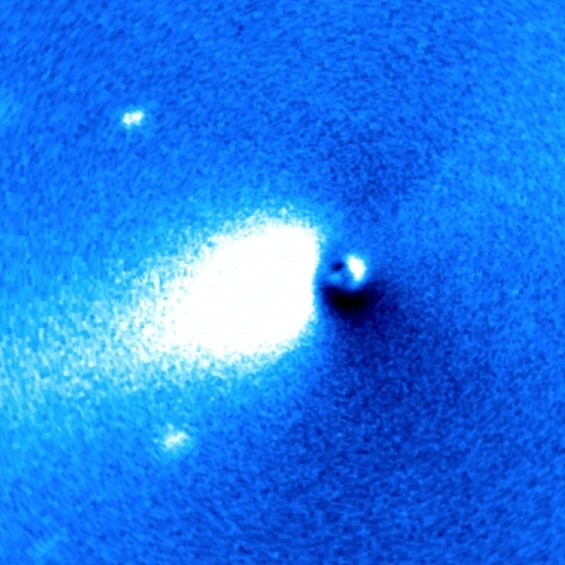SAN JOSE, CA — In the constant effort to understand 3I/ATLAS—the interstellar visitor now gripping the attention of researchers, intelligence agencies, and the public—my team and I conducted a clarity-preserving enhancement of one of the most unusual images captured of the object. What emerged from this refined analysis is not a typical cometary profile, not a random dust plume, and certainly not the behavior expected from a natural body plunging past the Sun.
Instead, the structure revealed is remarkably asymmetric, and visibly anchored around a nucleus that refuses to behave like a rotating, outgassing ice-rock mixture from the distant reaches of space.
The enhanced image shows a nucleus that is unmistakably bright, condensed, and sharply defined. Natural comets tend to smear light across a wider region, especially after perihelion, when outgassing should be violent, chaotic, and rotationally modulated. But the nucleus of 3I/ATLAS concentrates its light into a compact focal point with a geometric crispness that simply fails to align with the behaviors charted in cometary dynamics.
Adjacent to this central bright point is a pronounced dark notch—almost a shadow-cone or occlusion shape—implying a physical obstruction or structural surface facing the Sun. That shadowed region maintains its form across multiple independent observations taken days apart, despite the object allegedly spinning. If the object were rotating, this dark region would smear or reposition as the jet orientation changed. It does neither.
The most glaring anomaly, however, emerges in the asymmetric jet structure. On the left side of the nucleus, the enhanced image exposes a massive, lopsided plume that appears highly directional. The jet is not fanning outward like a comet tail pushed by solar wind. Instead, it is strongly concentrated along a single axis, almost as if being emitted through a fixed vent—or a nozzle.
The plume’s brightness gradient, revealed in the clarity pass, deepens the mystery: it is sharply delineated at the proximal end near the nucleus and then expands in a smooth, controlled diffusion pattern outward. Natural jets erupt in bursts, flickers, and spirals due to rotational torque. This one remains steady and anchored—an observation that Harvard astrophysicist Avi Loeb described as “not smeared by rotation,” an understatement echoed by the visual data itself.
Even more striking is the way the object transitions from intense luminosity on the jet-emitting side to a precisely defined darkened hemisphere opposite it. This creates a yin-yang-like effect that would require a highly specific surface morphology if natural, or deliberate orientation if artificial.
When we applied the lighter enhancement filters—which minimize distortion and avoid artificial textures—the same two-lobed optical pattern persisted. That consistency across contrasting enhancement settings argues strongly that these features are not digital artifacts, but inherent structural elements of the object itself.
Another subtle yet important element discovered in the cleaned version is the faint secondary plume rising from the lower region of the coma. It is weaker, softer, and more diffused than the dominant jet, but its presence reinforces the idea that multiple outflow structures exist on the surface.
Remarkably, the two do not conflict or swirl as one would expect from a tumbling body. They hold position like fixed exhaust channels on a stable platform. This is, without question, one of the most unusual signatures we have seen from any interstellar object thus far.
For our readers who have been following this story from the beginning—especially those who recognize the seriousness of 3I/ATLAS’s approach toward its December 19 close pass—this new analysis matters.
We must rely on evidence, not speculation. But when the evidence itself begins contradicting known cometary physics and instead presents patterns of controlled directionality, surface occlusions, and rotational stability, it becomes irresponsible to ignore the implications. These anomalies demand explanation. They demand transparency. And they demand continued observation as the object moves closer to Earth.
I urge NASA, ESA, and the relevant scientific bodies to release the complete HiRISE dataset, including the early-October imagery still missing from public view. This object is no longer just a curiosity—it is an international scientific priority. And as we continue to peel back the layers of what 3I/ATLAS is and is not, the public deserves to know what the world’s best instruments are seeing.
Follow USA Herald for ongoing, accurate, and evidence-driven reporting as we continue to analyze every new development surrounding 3I/ATLAS.



